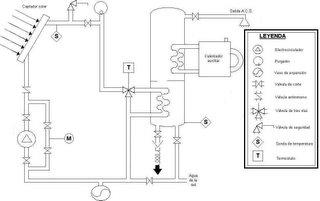
Heat transfer can be performed:
- Direct - is a single circuit, there is no separation between the primary and secondary, ACS circulates through the collectors. You get a good thermal performance and system features simplicity. The drawbacks are the use of materials that do not pollute the water, the risk of vaporization and freezing works at the network pressure (hazard collectors) can not be used antifreeze, increased risk of corrosion (air in water) Limescale and more possible legal restrictions.
- Hint - There a heat exchanger heat transfer from fluid to mix with the ACS. It is the most common. If the primary circuit has been added to antifreeze, has a higher density so it will cost more to amount (larger pump) and it expands more.
- Thermosiphon - Natural circulation. The deposit must be placed on the collectors to allow convection temperature difference. To facilitate the movement of water must have sufficient temperature difference T between the collector and storage tank and a height h greater than 30 inches between the tank and collectors. The greater than T h, the greater the energy to move the liquid. To avoid the risk of elevated temperatures in the tank is designed with larger volumes of 70 l / m 2 of collector.
- Electrocirculador - Forced circulation. Avoids the defects of natural circulation systems. The drawbacks are the need for power and control and regulation of the circulator. When the exchanger is at a lower level than the electrocirculador collectors is essential. We must also include a check valve to prevent the possible effect thermosiphonic night. An example of forced circulation system and could indirectly be shown in the figure below:
In the secondary circuit would be the battery together with an auxiliary power source (heater), which could be in series with it.
The advantages of this type of circuit is that you have a better control system has a number of security protection, increasing performance. It increases the number of applications that can be aimed and geographic location can be located.
The disadvantages are that it requires additional electrical circuit, a control system and the price is higher. It also has more maintenance.
0 comments:
Post a Comment